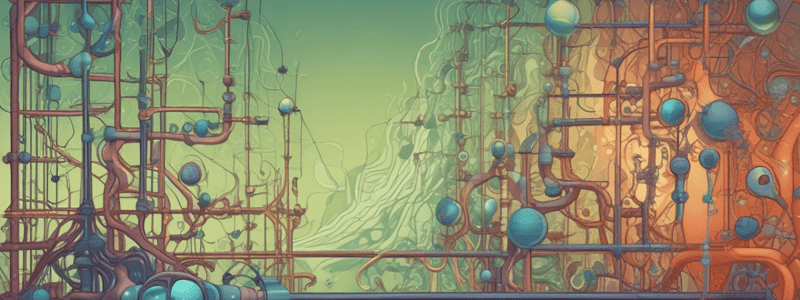Podcast
Questions and Answers
What is the effect of increasing substrate concentration on the rate of an enzyme-catalyzed reaction at low substrate concentrations?
What is the effect of increasing substrate concentration on the rate of an enzyme-catalyzed reaction at low substrate concentrations?
- The rate of reaction reaches a maximum value
- The rate of reaction decreases
- The rate of reaction increases linearly (correct)
- The rate of reaction remains unchanged
What is the Michaelis-Menten equation for the rate of an enzyme-catalyzed reaction?
What is the Michaelis-Menten equation for the rate of an enzyme-catalyzed reaction?
- v = km / [S]
- v = vmax - km [S]
- v = vmax [S]/(km + [S]) (correct)
- v = km [S]
What is the effect of increasing substrate concentration on the rate of an enzyme-catalyzed reaction at high substrate concentrations?
What is the effect of increasing substrate concentration on the rate of an enzyme-catalyzed reaction at high substrate concentrations?
- The rate of reaction decreases
- The rate of reaction continues to increase linearly
- The rate of reaction remains unchanged
- The rate of reaction reaches a maximum value (correct)
What is the term for the maximum rate of an enzyme-catalyzed reaction at high substrate concentrations?
What is the term for the maximum rate of an enzyme-catalyzed reaction at high substrate concentrations?
What is the term for the substrate concentration at which the rate of an enzyme-catalyzed reaction is half of the maximum rate?
What is the term for the substrate concentration at which the rate of an enzyme-catalyzed reaction is half of the maximum rate?
What is the effect of increasing enzyme concentration on the rate of an enzyme-catalyzed reaction?
What is the effect of increasing enzyme concentration on the rate of an enzyme-catalyzed reaction?
What is the purpose of the Lineweaver-Burk plot?
What is the purpose of the Lineweaver-Burk plot?
What is the catalytic efficiency of an enzyme?
What is the catalytic efficiency of an enzyme?
What is the term for the number of times a catalyst enters a reaction to form products per unit time?
What is the term for the number of times a catalyst enters a reaction to form products per unit time?
What is the effect of increasing substrate concentration on the Km value?
What is the effect of increasing substrate concentration on the Km value?
What is the rate of adsorption proportional to?
What is the rate of adsorption proportional to?
What is the effect of high pressure on the decomposition of PH3?
What is the effect of high pressure on the decomposition of PH3?
In the Langmuir-Hinshelwood mechanism, what is the rate of reaction v proportional to?
In the Langmuir-Hinshelwood mechanism, what is the rate of reaction v proportional to?
What is the relationship between the rate of adsorption and the rate of desorption in the Langmuir isotherm?
What is the relationship between the rate of adsorption and the rate of desorption in the Langmuir isotherm?
What is the effect of substrate concentration on the reaction rate in the Langmuir-Hinshelwood mechanism?
What is the effect of substrate concentration on the reaction rate in the Langmuir-Hinshelwood mechanism?
What is the role of the surface in heterogeneous catalysis?
What is the role of the surface in heterogeneous catalysis?
What is the approximate rate of change of intermediate species concentration during the steady-state approximation?
What is the approximate rate of change of intermediate species concentration during the steady-state approximation?
What is the relationship between the concentration of A and the concentration of intermediate species I under the steady-state approximation?
What is the relationship between the concentration of A and the concentration of intermediate species I under the steady-state approximation?
What is the rate of formation of product P in terms of the concentration of A under the steady-state approximation?
What is the rate of formation of product P in terms of the concentration of A under the steady-state approximation?
What is the condition for the steady-state approximation to be a good approximation?
What is the condition for the steady-state approximation to be a good approximation?
What is the relationship between the rate constant k and the temperature T according to the Arrhenius equation?
What is the relationship between the rate constant k and the temperature T according to the Arrhenius equation?
What is the effect of increasing the temperature by 10 K on the rate constant k?
What is the effect of increasing the temperature by 10 K on the rate constant k?





